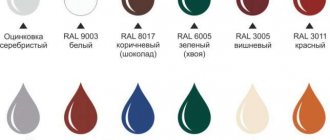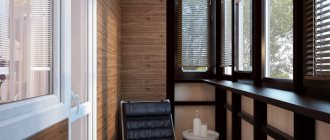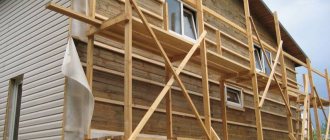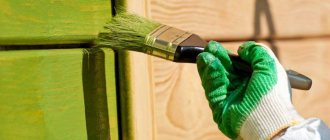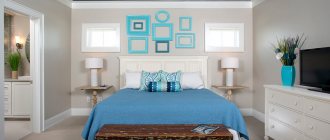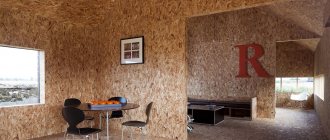The question of how to paint a balcony often arises among those who decide to renovate this room. Almost everyone can do this with their own hands, plus this is one of the most budget-friendly finishing options. But which paint should you choose? And are all surfaces painted the same? The answers to these questions should be known in advance.
Balcony paint: main types of paints
Painting the balcony must comply with certain requirements:
- Safety of materials for human health and the environment.
- The ability of the paint to withstand the influence of negative external factors - not to be washed off with water, not to fade in the sun, not to crack in the air, etc.
- Vapor permeability - so that moisture cannot accumulate in the walls.
Thus, several types of paints have become common for everyday use.
Acrylic
They are water-based, so they are suitable for interior decoration of any residential premises. Acrylic paint for balconies is easy to apply, diluted with water, does not smell anything and dries in a few hours. It has high resistance to abrasion and ultraviolet radiation, good vapor permeability and tinting that allows you to get a wide range of colors. Average paint consumption (with a two-layer coating) is 500 g per 1 sq. m. The result lasts 10 years.
Silicone
They have the longest service life - 20 years, but take a long time to dry out and have an unpleasant odor. Silicone paint forms a durable water-repellent coating and, due to its excellent plasticity, makes it possible to paint over noticeable defects. Resistance to abrasion and heat is high, in addition, the composition usually includes antibacterial additives, which eliminates the appearance of mold. To paint a balcony in one layer, you need to spend 200 g of paint per 1 square meter. m.
Latex
They form a waterproof film on the surface, dry quickly, but have low vapor permeability and are less resistant to ultraviolet radiation. Latex paint can be used to paint over minor defects in walls - cracks and small holes.
Alkyd
They are a mixture of synthetic resins and dye in a solvent, so they have a strong smell and are also washed off only with solvents (white spirit). They have good water-repellent properties, are resistant to impact loads, and create a dense film. At the same time, alkyd paints for balconies dry faster than oil paints.
Silicate
The material is based on liquid glass, which provides very strong adhesion to the surface. Because of this, silicate paints are difficult to remove, but are resistant to aggressive chemicals and ultraviolet radiation, as well as temperature changes. They perfectly permeate moisture, and their hardening time is 24 hours.
Water-based
They are considered obsolete due to high abrasion, poor resistance to low temperatures and rapid crumbling. But this paint can be used to cover ceilings on insulated balconies and loggias - if there is a need to save money.
Conclusion
Painting concrete walls has a number of undeniable advantages over other finishing methods. It is comparatively cheaper, simpler, if painted correctly, they will last you a very long time, they are easy to care for, repairs take place quite quickly - it will only take a few days for all the layers to dry. It will take many years before preventive maintenance can begin. The cosmetic intervention itself will be minimal - clean up the exfoliated areas and repaint them.
Even good paint can be much cheaper than other finishing methods. You also need a little of it - based on the pre-measured area, and by finding a container with the specified flow rate, you will reduce costs to a minimum.
Painting different surfaces
Initially, balcony walls are concrete or brick and plaster. But finishing and insulation make the surface different, and it is not clear how to paint a balcony if it has a wooden, plastic, metal or even stone covering?
Concrete, brick, plaster
Such a balcony should first be finished for painting - clean the surface and treat the moldy areas, apply a primer. For cleaning, sandpaper, metal brushes and even a grinder are used. Any cracks and potholes are filled with putty or cement. It is better to choose a brush that can penetrate into deep pores (these materials are characterized by roughness). Acrylic, silicate, latex, and silicone paints are suitable.
Drywall
According to the technology, after fastening, drywall panels are covered with putty and rubbed with abrasive materials to create a smooth surface. So painting requires just a layer of primer, and water-based paints are best suited for this - in the case of a balcony, these are acrylic and water-based. Usually you need two or more layers of paint, the last one going in the direction of the light.
Wood (including lining)
Painting a balcony with a fiberboard or chipboard finish should be carried out after preparing the surface - for this, use olive, oxol or alkyd primer on penaflalic varnish. This reduces paint consumption and creates an additional protective film on the wood. These surfaces are often coated with clear varnish, but alkyd paints and varnishes provide equally impressive results. To save money, you can use regular oil paints, which take a long time to dry.
If there are wooden frames on the balcony, they also need to be prepared - cleaned, coated with drying oil (in two layers) and primer. Irregularities are corrected with putty. In this case, the frames and wooden doors need to be painted with different compounds than the walls.
Plastic
Typically, additional coating is required when siding or panels become faded in the sun over time. For this purpose, there are special paints for PVC products, which are produced in spray cans; they extend the service life of the finish. But before painting, it is also better to clean the panels: remove them, treat them with a solvent (it can be replaced with alcohol), hang them back and then apply paint.
Profile sheet
After 10-15 years of operation, traces of corrosion appear on such a surface, and painting it is cheaper than dismantling and installing a new corrugated sheet. But before applying paint, rust must be removed - with sandpaper or a means for converting it. It is also usually necessary to remove traces of oil stains and remnants of old paint. After this, alkyd materials are often used.
Preparing the wall
Any painting work begins from this point. Some modern paints, for example, those with a latex base, are able to smooth out minor surface defects and “tighten” shallow cracks. However, such compositions are not intended to strengthen the structure, so you should definitely prepare the surface before painting.
Work algorithm:
- Clean the walls from the old coating, remove all loose pieces of plaster, bricks or mortar.
- If necessary, perform bactericidal treatment of the surface against fungus and mold.
- Clean the surface from dust and dirt, preferably blow it with compressed air if you have a compressor. An alternative is to use a household vacuum cleaner.
- Prime the wall with a special moisture-resistant compound. This will improve the quality of the coating and also provide additional waterproofing properties.
- Seal seams and detected defects using compounds suitable for outdoor work.
- Re-prime the treatment areas.
Depending on the chosen interior style and the condition of the brickwork, one more item can be included in this list - plastering the surface. For this purpose, moisture-resistant compounds for universal use are used. They are more expensive than usual, but will provide additional resistance to adverse weather conditions.
Required Tools
It is more efficient to paint walls and ceilings with a roller, which gives an even coating. And paint all corners and narrow elements (the same window frames) separately with a brush. But here it can be difficult with the intensity of the color - the brush gives a thicker coating. This can be avoided by stirring the paint in the can not only before starting the repair, but also during the process itself. This way the shade will apply evenly.
It is better to buy a mohair roller, and brushes should work well on a rough surface (this will be specified when purchasing). These tools are affordable and easy to replace if necessary. Also, if the coating is porous and you want to make the surface as smooth as possible, you can buy special sealants.
When using varnishes, it is better to get a paint sprayer, because it is easier to create a smooth coating without borders or smudges. Professionals can do this with ordinary tools, but it is difficult to achieve this with your own hands.
Thematic video from professionals
Tips from the pros will help you understand the nuances of finishing a balcony:
Video instructions for painting walls
How to apply textured paint correctly
The use of paint, varnish and other decorative materials is an affordable and effective way to improve a balcony or loggia. Almost all stages can be completed independently, without the involvement of specialists. If you approach this event with desire and imagination, you will get another beautifully decorated room - cozy and comfortable.
YOU MAY ALSO BE INTERESTED
What color should I paint the balcony?
Whatever the material, it is the color that shapes the atmosphere in the house. The balcony is no exception - today it is often turned into a full-fledged living space. But the choice of shade in this case is slightly different from other rooms - you need to take into account the small dimensions, on which side of the world the balcony is located, etc.
UV amount
Sunlight warms, but under its influence the paint fades. This is especially true for black and bright saturated colors. And white paint can turn yellow when exposed to ultraviolet radiation, so if the choice is between basic colors and you don’t want to frequently renew the coating, it’s better to stick to shades of gray.
However, you can benefit from these features - for example, making the floor on the balcony warmer. Dark surfaces absorb light, while light surfaces reflect it. So, by combining light walls with a dark floor, you can achieve an effect where light begins to reflect from the walls and, as a result, is absorbed by the floor surface.
If the balcony is on the south or east side, the walls can be painted in rich colors. But for the north or west, pastel colors are desirable.
Matching colors
The main goal when decorating a balcony is its visual expansion. To make the space look less elongated, a smaller wall can be painted a darker shade than the rest. And all pastel colors will increase the space. Muted colors allow you to retouch defects, etc.
Most often, the following colors are used in the interior of a balcony:
- White is a universal option for the background, compatible with the entire palette.
- Blue - ideal for a balcony that is planned to be turned into a relaxation area (it is soothing and relaxing). Shades of blue are combined with gray on the ceiling and floor, as well as rich blue on the walls.
- Pink and beige are good for zoning space. This applies specifically to the shades of these colors: for example, with a milky background on the walls, you can paint one of them in a fuchsia tone and thus highlight a relaxation area.
- Earthy tones – associated with the natural environment and combined with the texture of wood paneling. It can be sand, brown, etc. They create a warm atmosphere that does not irritate the eye and is soothing.
- Orange - makes the interior bright, especially if combined with green flooring. But it is important that the colors are equally saturated.
- The color of spices refers to the shades traditional for African homes: cinnamon, turmeric, cardamom. They harmonize perfectly with a light yellow or beige background. Furniture is preferably made of mahogany.
Important: when choosing a color, you need to remember the surface texture. Rough paint looks darker than smooth paint. On a matte finish the shade will look warmer than on a polished one. This difference adds finishing options.
Adjustment of space
If the parameters of the balcony for painting are not ideal, you can use color contrast. This is a well-known design technique that visually changes the space.
Dark walls and floor, light ceiling
Allows you to balance vertical and horizontal planes. They apply stretching of tones from light to dark, which removes excess load. Based on the general tone, the color of furniture and accessories can be cold or warm.
Dark floor and ceiling, light walls
Corrects the problem of the ceiling being too high. Painting the ceiling and floor in dark, warm colors visually brings them closer together. Cold ones will have the opposite effect.
Dark floor, light ceiling, bright walls
Suitable for the opposite situation - when the ceiling is too low. The ceiling can be painted white, and the flooring can be made as dark as possible. The result will be a feeling of “floating”. The walls are very rich and can even be painted with vertical stripes. If the balcony is very narrow and long, then one of the walls can also be made white and light curtains added.
Light ceiling and walls, dark floor
A good option for small balconies with low ceilings. All surfaces, with the exception of the floor, need to be lightened, so they should be light, as if weightless. And a dark floor will add “grounding” to the interior. But you can add white baseboards and the same cornices, and also hang transparent tulle on the windows.
Introduction
Preparatory and painting work should be carried out in well-ventilated areas to minimize the negative impact on your health and the health of your loved ones. Do not allow children and animals into the work area, and use protective clothing yourself - gloves, a respirator and plastic goggles. Keep in mind that if paint gets on the fabric of your clothing, it most likely will not wash off, so use clothes that you won’t mind throwing away.
Additional recommendations
First of all, it is worth considering the specifics of the approach to the upcoming repair. The easiest way to choose paint is to monotonously cover the entire wall with one color. If you choose a coating to paint bricks in one tone and joints in another, you can proceed from both the principle of correspondence and the principle of contrast. Caution: Those who are not well versed in these principles and their application should consult a professional designer. And you also need to answer the question from the very beginning: do you need a smooth or textured surface?
Style features
Knowing the basics of choosing shades for painting a balcony, you will be able to determine a unified style. There are several popular styles with distinctive features.
Shabby chic
A distinctive feature of the shabby chic style is white color with a pronounced aging effect. Scuffs and neglect are created on the walls and pieces of furniture.
Mediterranean
The basis of the Mediterranean style is the use of light shades. In addition to light walls, plants are placed on the balcony.
Japanese
When arranging a balcony in Japanese style, the walls are painted cream or beige, and the beams are left dark to create contrast. You can diversify the Japanese interior with national ornaments, bamboo decorations and low furniture.
Moroccan
The Moroccan style is characterized by the abundant use of exotic interior items, made in bright colors. When arranging a balcony, you can use colorful carpets, furniture and Moroccan dishes. The walls are finished with beige-pink plaster.
Chalet
You can create the style of a chalet using wooden lining, which is used to cover the walls. The surface of the wood is treated with stain or wax. The chalet's style is characterized by a color scheme of terracotta, chocolate and cream tones.
Eco style
Modern ecological style involves the use of natural shades, including beige, sand and olive. Straw and bamboo inserts are an excellent addition.
Loft
When finishing in a loft style, a light gray wall color is used as the basis. One of the bases can be made in bright colors or create the texture of aged wood.
